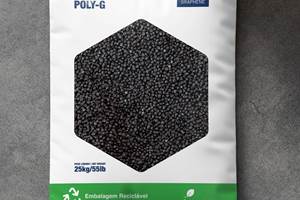Sustainable Resource Management of Plastic Feedstocks
How Encina sees its future in the circular economy.
Encina makes feedstock monomers from end-of-life plastics. In April, the company made news with a big investment to build its first commercial scale facility in Pennsylvania. Recently I spoke with Sheida Sahandy, Chief Sustainability Officer and General Counsel at Encina, about her vision for the circular plastic industry.
Encina’s process begins with sorted, post-consumer waste from MRFs, along with high-value scrap material. A second sort is performed, removing contaminants and redirecting fractions that can be mechanically processed to other recyclers. The catalytic transformation process is capable of recycling a range of resins in the future, but right now the company is focusing on PE, PP, and PS. Using pyrolysis with a catalyst, the sorted material is broken down into aromatic hydrocarbons: benzene, toluene, and xylene. The products are virgin-quality and are purchased by resin producers to create polymer with recycled content.

Structural depiction of aromatic compounds produced by Encina. From left: benzene, toluene (methylbenzene), and xylene (dimethylbenzene). Xylene has three isomers, the para positioning is shown.
Image Credit: Adapted from PubChem CID# 241, 1140, & 7809.
According to Sahandy, the benefits extend beyond keeping end of life products out of the landfill system. An immediate benefit is the smaller carbon footprint of plastic production from the recycled feedstock, when compared to production from petrochemicals. A longer term, policy-level benefit comes from creating a valuable end-product from something previously thought of as waste. This encourages better collection and keeps materials in the value chain.
Encina presents its process as a complement to rather than a replacement for mechanical recycling. The process can accept a wider swathe of resins and materials can pass through the process many times. Because the material is taken back to the monomer stage, the problem of degradation is ameliorated.
“I think of it as rewinding the chemical process; rewinding, reusing, and rewinding again,” said Sahandy.
Pennsylvania and Beyond
The announced Pennsylvania plant is currently in the permitting and planning stages, with a target of completion in 2024. When completed, it will have a capacity of 450,000 tons, an amount of plastic that could fill a football stadium. It’s a substantial number: the Association of Plastics Recyclers placed the total amount of plastic recycled throughout the entire US at 2.4 million tons in 2020.
But Encina has no intention of stopping there. They are looking at possible future sites in the US and internationally. Locations have not yet been determined, but Encina is looking to play a role in boosting recycling capacity in communities where it is lacking.
Catalytic pyrolysis falls under the increasingly large umbrella of “advanced recycling”, the regulation of which has been the topic of much legislative grappling in many state legislatures over the past few years. Some recycling programs have been criticized for using plastics to create fuel oil—potentially slowing the transition to a carbon-free energy system—or for simply using the plastic itself as a fuel.
Encina seems confident that regulation is becoming more refined as understanding of new technology improves and will accurately reflect what they actually do—which is not collection, incineration, or manufacturing of plastics. Unlike some of the processes in this broad category, Encina’s is aimed at providing feedstocks that are from plastics and for plastics. On September 21, American Styrenics announced an offtake agreement with Encina for the purchase of up to 250,000 tons annually. The company will incorporate Encina chemicals into its polystyrene products, in support of its goal of 30% recycled content by 2030.
Synergetic Solutions for Managing Plastic as a Resource
Sahandy doesn’t see recycling as enabling infinite expansion of production, but rather as one of many parallel solutions including reuse, plastic alternatives where appropriate, and new developments like bioplastics. She cautioned that outright bans on plastic could be very harmful to some communities, for example where municipal tap water supplies are contaminated.
“We should be selective about when and where we switch out, because in many situations there is no substitute, and the whole cycle should be managed. Our ethos is not ‘pro-plastic,’” she said. “Our ethos is ‘better resource management.’”
Related Content
General Polymers Thermoplastics to Further Expand Distribution Business
NPE2024: Following the company’s recent partnership buyout, new North American geographic territories are in its sight.
Read MoreGerdau Graphene Launches “First” Graphene-Enhanced PE Additive Masterbatch for Extruded Packaging and More
The company has also partnered with conglomerate Sumitomo Corp. for distribution of its graphene-enhanced masterbatches in Japan.
Read MoreNPE2024 Materials: Spotlight on Sustainability with Performance
Across the show, sustainability ruled in new materials technology, from polyolefins and engineering resins to biobased materials.
Read MoreICIS Launches: Ask ICIS Generative AI Commodities Assistant
Said to be the first of its kind, this AI assistant will enhance access to ICIS’ intelligence and insights for the energy and chemical markets.
Read MoreRead Next
For PLASTICS' CEO Seaholm, NPE to Shine Light on Sustainability Successes
With advocacy, communication and sustainability as three main pillars, Seaholm leads a trade association to NPE that ‘is more active today than we have ever been.’
Read MoreBeyond Prototypes: 8 Ways the Plastics Industry Is Using 3D Printing
Plastics processors are finding applications for 3D printing around the plant and across the supply chain. Here are 8 examples to look for at NPE2024.
Read More
























